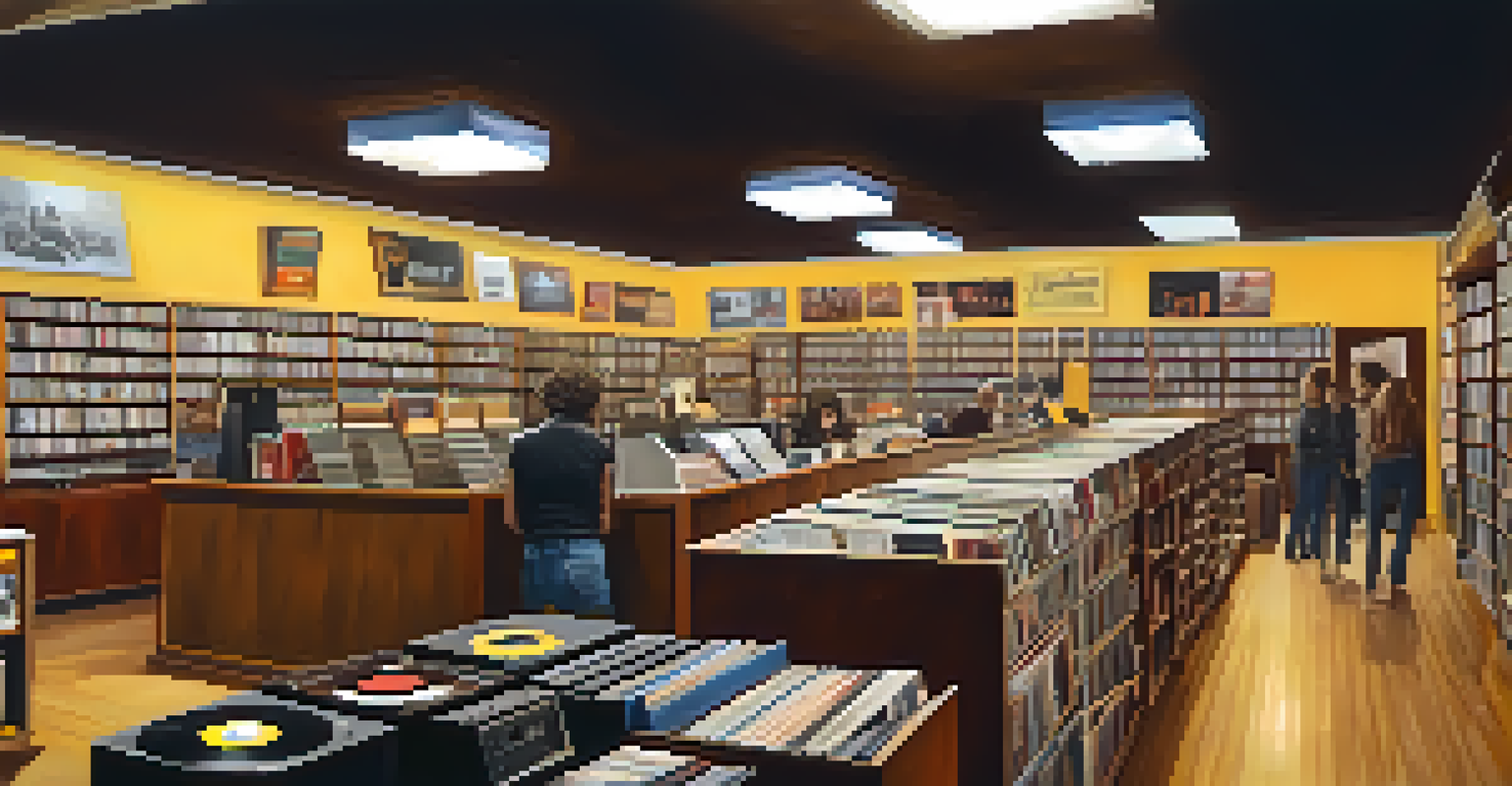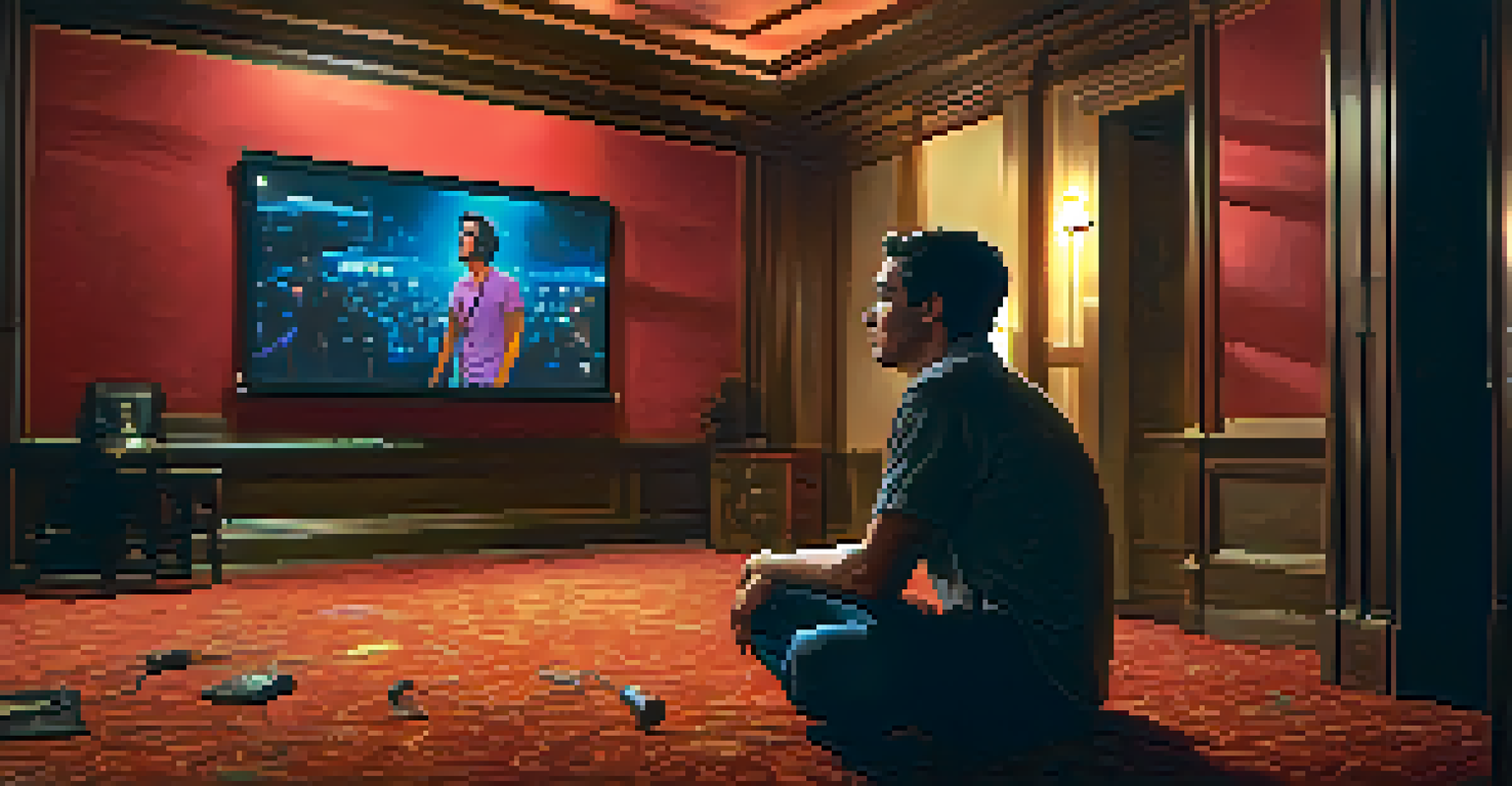How Hollywood Soundtracks Shape Music Trends in the Industry

The Power of Soundtracks in Film and Culture
Soundtracks have become an integral part of the cinematic experience, transcending just background music. They evoke emotions, set the tone, and can leave a lasting impression on audiences. Think about iconic movies like 'Titanic' or 'Guardians of the Galaxy'—the music often becomes as memorable as the films themselves.
Music can change the world because it can change people.
Moreover, soundtracks can introduce listeners to new genres and artists, sometimes even revitalizing older tracks. For instance, the inclusion of classic songs in modern films often leads to a resurgence in interest, as newer generations discover these hidden gems. This cross-generational appeal showcases the ability of soundtracks to bridge gaps in musical tastes.
As a result, soundtracks not only enhance the storytelling of films but also play a crucial role in shaping cultural moments. They reflect the zeitgeist of their times, influencing what people listen to beyond the theater. In essence, soundtracks serve as a lens through which we can examine evolving musical trends.
Influencing Emerging Artists and Genres
Hollywood soundtracks have a knack for spotlighting emerging artists and lesser-known genres. When a film features a fresh indie band or a unique style of music, it can catapult that artist into the mainstream. For example, the use of Hozier's 'Take Me to Church' in various media significantly boosted his visibility and fan base.

This phenomenon is not limited to just one genre; soundtracks can introduce audiences to a diverse array of musical styles. From hip-hop to folk, the range of genres represented in film soundtracks is vast and varied. This exposure can lead to a shift in popular music tastes, as listeners seek out similar sounds after hearing them in a compelling film context.
Soundtracks Shape Cultural Trends
Film soundtracks not only enhance storytelling but also reflect and influence musical trends across generations.
Consequently, filmmakers often collaborate with music supervisors to curate soundtracks that not only fit the film's narrative but also highlight contemporary music trends. This collaborative effort creates a feedback loop where film and music industries influence each other, paving the way for new musical movements.
Case Studies: Successful Soundtracks and Their Impact
Let's look at the soundtrack for 'A Star is Born,' which played a pivotal role in reviving interest in country and pop music. Featuring powerful performances by Lady Gaga and Bradley Cooper, the soundtrack topped the charts and introduced many to contemporary country sounds. This not only boosted the artists' careers but also influenced many aspiring musicians.
Soundtracks are the emotional backbone of a film, influencing how audiences feel and remember the story.
Another notable example is the 'Guardians of the Galaxy' soundtrack, which combined classic hits with a modern twist. This eclectic mix sparked a renewed interest in '70s and '80s music, leading to a surge in playlists celebrating that era. The film's success demonstrated how nostalgia can effectively shape current music trends.
These case studies highlight the tangible effects that soundtracks can have on the music industry. By effectively blending storytelling with musical artistry, filmmakers can create cultural phenomena that resonate with audiences and inspire future generations of artists.
The Role of Music Supervisors in Soundtrack Creation
Music supervisors play a crucial role in the soundtrack creation process, acting as the bridge between filmmakers and musicians. They are responsible for selecting the right tracks that align with the film's vision while also considering current music trends. Their expertise can make or break a soundtrack's success, as they curate songs that resonate with audiences.
In many cases, music supervisors seek out emerging artists to feature in soundtracks, giving them a platform to reach wider audiences. This not only diversifies the music landscape but also fosters innovation within the industry. By championing new talent, music supervisors help shape the future of the music scene.
Emerging Artists Gain Exposure
Soundtracks often spotlight new artists and genres, helping them reach mainstream audiences and shift musical tastes.
Ultimately, their work ensures that film soundtracks remain relevant and influential, adapting to the ever-changing musical landscape. Their ability to tap into the cultural pulse is what allows soundtracks to continue driving music trends forward.
The Connection Between Film Genres and Music Styles
Different film genres often align with specific music styles, creating a symbiotic relationship that enhances both art forms. For instance, action films frequently feature high-energy tracks that get the adrenaline pumping, while romantic comedies might lean towards softer, melodic tunes. This intentional pairing helps set the mood and guides audience expectations.
Moreover, as genres evolve, so do the musical styles associated with them. For example, the rise of superhero films has seen an increase in orchestral scores mixed with modern electronic sounds, creating a fresh approach to action sequences. This evolution keeps film soundtracks exciting and relevant, reflecting contemporary musical trends.
By understanding the connection between film genres and music styles, creators can craft soundtracks that truly resonate with viewers. This interplay not only enhances the film's narrative but also influences the direction of musical trends in the industry.
Nostalgia: A Powerful Tool in Soundtrack Selection
Nostalgia is a powerful emotion that filmmakers often harness when selecting songs for their soundtracks. By featuring familiar tracks from the past, filmmakers can evoke strong memories and feelings in the audience. This tactic not only enriches the viewing experience but can also drive listeners to revisit older music, creating a revival of interest.
For example, the use of '80s hits in films like 'Stranger Things' taps into a sense of nostalgia for many viewers. This not only attracts older audiences who grew up with these songs but also introduces younger viewers to classic tunes, expanding their musical horizons. The result is a delightful blend of old and new, as different generations bond over shared musical experiences.
Nostalgia Drives Music Selection
Filmmakers leverage nostalgia in soundtracks to evoke emotions and connect audiences with both classic and contemporary music.
This nostalgic approach often leads to increased streaming and sales for the featured artists, making it a win-win situation for everyone involved. By leveraging nostalgia, soundtracks can effectively shape music trends while also creating a lasting emotional connection with audiences.
The Future of Soundtracks in an Evolving Music Landscape
As the music industry continues to evolve, so too will the role of soundtracks in shaping trends. The rise of streaming platforms has changed how music is consumed, enabling filmmakers to reach wider audiences with curated playlists. This shift presents new opportunities for both filmmakers and musicians to collaborate and innovate.
Moreover, advances in technology are paving the way for more immersive experiences, such as virtual reality films that incorporate interactive soundtracks. This could redefine how audiences engage with music in film, leading to even more dynamic and memorable connections. The future looks bright for soundtracks as they adapt to these changes.

Ultimately, as films and music continue to intertwine, soundtracks will remain a vital component of both industries. They have the power to shape trends, introduce new talent, and create unforgettable moments that resonate long after the credits roll.